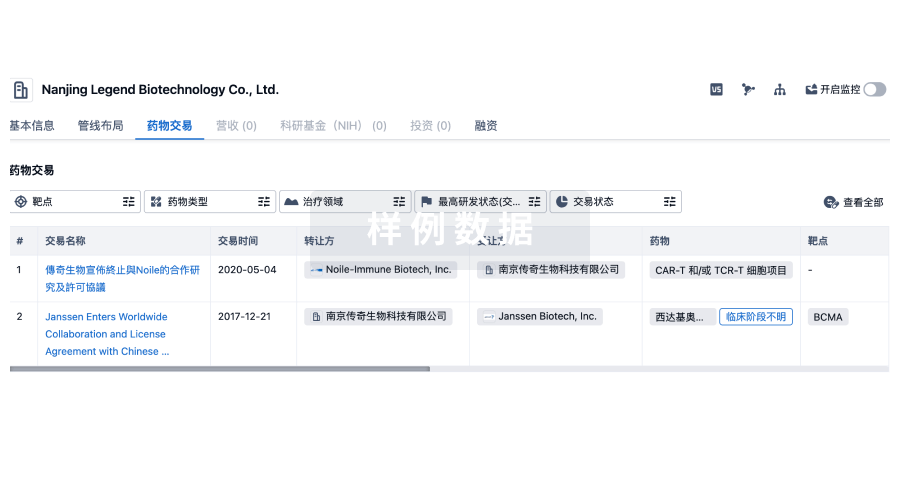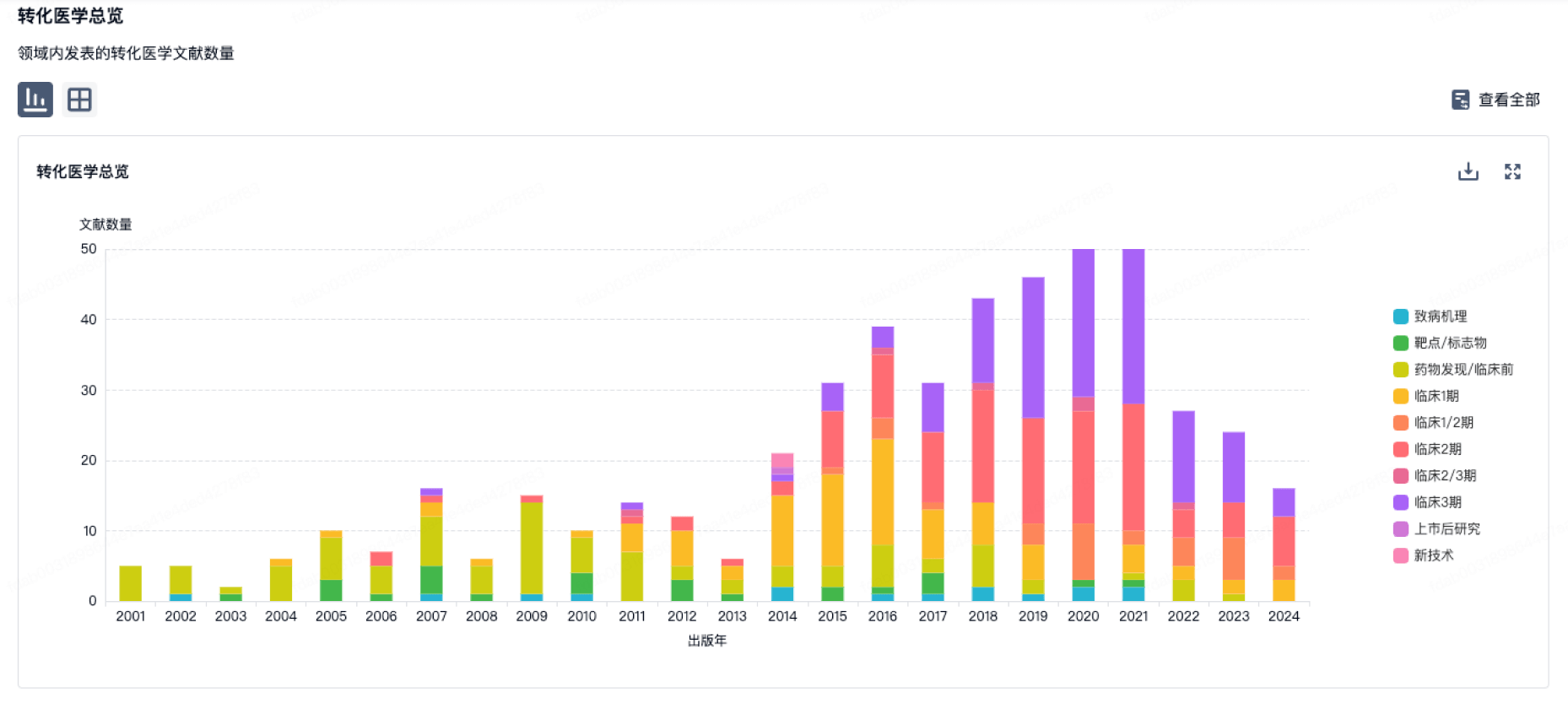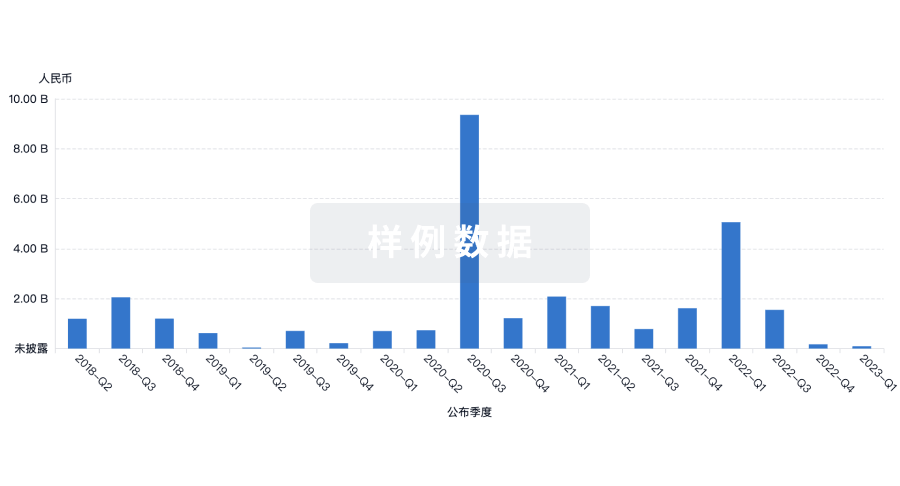预约演示
更新于:2025-10-30

BASF SE
更新于:2025-10-30
概览
关联
2
项与 BASF SE 相关的药物US20240390413
专利挖掘靶点- |
作用机制- |
原研机构 |
在研适应症 |
非在研适应症- |
最高研发阶段药物发现 |
首次获批国家/地区- |
首次获批日期- |
IL289744
专利挖掘靶点 |
作用机制- |
在研机构 |
原研机构 |
在研适应症 |
非在研适应症- |
最高研发阶段药物发现 |
首次获批国家/地区- |
首次获批日期- |
54
项与 BASF SE 相关的临床试验NCT04303468
The Effects of a GABA Supplement Versus a Placebo on Glucose Tolerance and Blood Pressure in Prediabetics
In this double-blind parallel placebo controlled intervention study the effects of 3 times daily 500 mg gamma-aminobutyric acid (GABA) supplementation on glucose tolerance and cardiovascular health will be assessed in prediabetics.
开始日期2020-09-29 |
申办/合作机构 |
NCT04531137
Conjugated Linoleic Acid Combined With Nutrition Counseling Consequences on Body Weight and Body Fat Mass in Overweight and Obese Adult
This study has purpose to assess the effect of conjugated linoleic acid (CLA)-fortified milk powder with nutrition counseling and nutrition module in body weight and body fat mass among overweight and obese adult in Indonesia
开始日期2020-08-05 |
申办/合作机构 |
NCT05037890
The Effects of Plant Sterol and Plant Stanol Ester Enriched Foods on Liver Inflammation in Subjects at Risk to Develop NASH
This study is a randomized, placebo-controlled, double blinded pilot study to assess the effect of consuming plant sterol or plant stanol esters (3 grams/day) for 6 months on ALT concentrations in subjects with elevated ALT concentrations, i.e. who are at risk to develop NASH.
开始日期2020-02-20 |
申办/合作机构  Maastricht UMC+ Maastricht UMC+ [+2] |
100 项与 BASF SE 相关的临床结果
登录后查看更多信息
0 项与 BASF SE 相关的专利(医药)
登录后查看更多信息
1,328
项与 BASF SE 相关的文献(医药)2026-01-01·JOURNAL OF COLLOID AND INTERFACE SCIENCE
Directed stratification in polymer–latex film blends via pH and drying control
Article
作者: Plaha, Tejveer Singh ; Ragunathan, Kaliappa ; Walker, Gilbert C ; Li, Xiaochong ; Kalhori, Dianoosh ; Zhao, Cheng-Le ; Halimi, Ilias ; Fuku, Richard ; Liu, Yang ; Soleimani, Mohsen ; Foley, Nicholas ; Lai, Yi-Fang ; Winnik, Mitchell A
HYPOTHESIS:
Stratification in polymer-colloid films is governed by interfacial interactions, component miscibility, and drying kinetics. We hypothesize that introducing a pH-responsive, acid-rich oligomer (ARO2) into latex films enables controlled vertical phase separation through electrostatic tuning and evaporation rate modulation.
EXPERIMENTS:
We formulated latex-polymer films by blending ARO2 (8 wt% acrylic acid, Mₙ ≈ 4000 Da) with latex particles (dh = 274 nm), varying pH (8.2-9.5), relative humidity (RH: 15-45 %), and ionic strength (0-50 mM NaCl). Förster Resonance Energy Transfer (FRET) was used to quantify ARO2-latex interdiffusion, while vertical distribution was characterized using confocal laser scanning microscopy (CLSM) and cross-sectional atomic force microscopy (AFM).
FINDINGS:
FRET measurements indicated limited molecular mixing in dispersion (ΦET ≈ 0.06), creating conditions favorable for stratification during drying. At pH 9.5 and 15 % RH, electrostatic repulsion between ionized ARO2 and latex particles, combined with size ratio (α ≈ 18) and moderate Péclet numbers (Pe ≈ 2.1), drove diffusiophoretic transport of ARO2 toward the evaporating interface. CLSM and AFM revealed a distinct ARO2-rich surface layer (10-20 μm thick) under these conditions, while slower drying or increased salt concentration suppressed segregation. This controllable stratification mechanism enables design of structured polymer-latex coatings: pH > 9 + low RH promotes surface enrichment, while pH < 8 or high RH yields uniform distribution.
2025-12-01·TRANSGENIC RESEARCH
Do confined field trials add value for the environment risk assessment of genetically modified Brassica napus L. in Japan?
Article
作者: Nakai, Shuichi ; Inoue, Koichi ; Takamoto, Kei ; Tsuda, Mai ; Inazu, Kaori
The environmental risk assessment (ERA) of genetically modified (GM) crops in Japan requires collecting data from a comparative study of a GM and non-GM control in an in-country confined field trial (CFT). This in-country CFT requirement is used to address concerns that differences in the local environmental conditions may lead to differences in growth and/or risks of GM crops. However, this requirement for in-country CFT has recently been exempted for certain GM maize and GM cotton traits, and instead CFT data from other countries are used to inform the ERA of these GM events. However, in-country CFTs continue to be required for GM B. napus. Our objective is to assess whether using B. napus as a host crop increases the potential for differences between GM B. napus and conventional B. napus that may have an impact on biodiversity occurring only under the Japanese environment. In this paper agronomic data was compiled from seven local CFTs of GM B. napus events to assess the potential for differences between GM and non-GM B. napus for three key areas; competitiveness, potential to produce harmful substances, and outcrossing. Considering these elements, the need for conducting CFTs locally for ERA of future GM B. napus traits is discussed. The assessment concluded that conducting CFT locally is not necessary for GM B. napus events if traits do not bring competitive advantage or produce harmful substances only under Japanese environment.
2025-12-01·TOXICOLOGY
Mathematical modelling reveals compound-specific stress pathway activity
Article
作者: Burgers, Elsje J ; Leist, Marcel ; Beltman, Joost B ; Bouwman, Peter ; Ternes, Philipp ; Sharma, Raju P ; Renner, Nadine ; Verlohner, Andreas ; van de Water, Bob ; Zickgraf, Franziska M ; Wijaya, Lukas S ; Schildknecht, Stefan ; Danilyuk, Tamara Y ; Rocker, Nicole
Drug-induced liver injury (DILI) is a major problem for the drug development industry. It has been suggested that activation of stress pathways within cells is an important indicator of DILI. In this project, we aimed to develop a mathematical model of invoked stress responses by three compounds with high DILI liability: nitrofurantoin, diclofenac and ketoconazole. To this end, we used imaging data from HepG2 cells and cell-associated compound and intracellular glutathione measurements. We initially developed a model for the integrated and oxidative stress responses following nitrofurantoin exposure. Subsequently, we expanded this to simulate responses to diclofenac and ketoconazole. To apply the model to these compounds multiple parameters required recalibration, yet the structure of the model was unchanged. Our analysis shows that the magnitude of interactions between transcription factors and downstream targets can differ even when the activated pathways are the same.
819
项与 BASF SE 相关的新闻(医药)2025-10-28
·起源思维
2025年10月28日,武汉禾元生物科技股份有限公司(以下简称“禾元生物”)正式叩开上海证券交易所科创板的大门,证券代码“禾元生物”。作为科创板成长层首批以新注册制标准上市的企业,禾元生物的亮相,远不止是一家公司的资本化里程碑。它更像一束强光,照亮了“植物源重组蛋白”这一曾备受争议的冷僻赛道,标志着中国在生物制药尖端技术平台领域,实现了从概念验证到产业化破局的重大跨越。
一、二十年磨一剑:从“一篇论文”到“一座工厂”
禾元生物的故事,始于一份科学家式的执着。其创始人、中国科学院院士杨代常教授,将实验室里水稻胚乳作为生物反应器的发现,一步步变成了改变行业的颠覆性技术。近二十年的光阴,公司从一个科研课题,成长为全球植物源重组蛋白领域的领军企业。
根据弗若斯特沙利文的报告,禾元生物的核心产品——植物源重组人血清白蛋白(OsrHSA),目前在全球范围内是研发进度最快的同类产品,已进入III期临床试验阶段。这背后,是近乎偏执的研发投入:近三年累计研发投入超8.5亿元,研发费用率常年维持在40%以上,远超科创板平均水平。
然而,高投入也伴随着高风险与长期期。招股书显示,公司目前尚未实现盈利,2021-2023年累计亏损超过12亿元。在OsrHSA这款“押上全部身家”的核心产品未获批上市前,这种“战略性亏损”如同悬在头顶的达摩克利斯之剑。市场在惊叹其技术前瞻性的同时,也不免担忧其商业化进程能否跟上资本的耐心。
二、财务镜像:高估值下的“投入”与“产出”悖论
禾元生物的招股书呈现出一幅典型的“硬科技”企业画像:高增长、高投入、暂未盈利。
营收爬坡与产品管线:公司目前微薄的收入主要来自其他重组蛋白的科研试剂销售,与巨额的研发支出相比可谓杯水车薪。其价值完全由在研管线驱动,除OsrHSA外,植物源重组人乳铁蛋白、胰蛋白酶抑制剂等产品也陆续进入临床前研究。这种“把所有鸡蛋放在一个技术篮子里”的模式,是其高估值的来源,也是最大的风险点。
“输血”与“造血”的赛跑:此次IPO募资逾25亿元,主要投向“植物源重组人血清白蛋白产业化项目”及补充流动资金。这引发了一场关键问询:在核心产品商业化前景尚未完全明朗前,巨额的资本开支是否会成为公司的财务黑洞?监管层在问询中重点关注了其现金流状况及未来三年的资金使用规划,公司则以详尽的敏感性分析和投产时间表予以回应,展现了对其技术转化效率的自信。
三、资本市场的三重“炼金石”
禾元生物的上市之路,是一次对技术、政策和市场的全面压力测试。
技术路径之争:与传统微生物发酵、动物细胞培养等主流技术路径相比,植物源体系曾因表达量、纯化工艺等问题备受质疑。审核过程中,交易所多轮问询直指技术核心:水稻种植的规模化与标准化、产品与人源血清白蛋白的等效性、以及能否最终通过药监部门的审批。禾元生物用超过1000例的临床试验数据、与国际巨头巴斯夫在农业技术上的合作,有力地证明了其技术路线的可行性与独特性。
知识产权护城河:作为技术驱动型公司,禾元生物构建了覆盖载体构建、重组蛋白表达、纯化工艺的全链条专利壁垒,拥有国内外授权专利百余项。这套严密的专利网络,是其应对未来国际竞争最坚固的“盾牌”。
科创板“新标准”的试金石:作为成长层首批企业,禾元生物满足了“研发投入+核心技术”的综合性指标。其成功过会,本身就验证了科创板支持“尚在爬坡期”但具备全球竞争力硬科技企业的决心,为后续类似企业树立了标杆。
四、行业变局:万亿市场的“破壁者”
禾元生物所处的赛道,正面临历史性的机遇与挑战。
机遇窗口:人血清白蛋白全球市场规模超千亿元,且长期供不应求。一旦OsrHSA成功上市,将彻底打破血浆采集的资源限制,解决潜在的病毒污染风险,重塑市场格局。此外,在“粮食安全”和“生物制造”的国家战略下,其“用稻谷生产蛋白”的模式具有极高的战略价值和广阔的想象空间。
挑战并存:巨头环伺是不得不面对的现实。不仅有大冢制药等持有已上市重组白蛋白产品的对手,更有众多采用其他技术路线的公司在紧追慢赶。此外,市场教育和医生、患者对新产品接受度,将是其商业化道路上必须翻越的另一座大山。
禾元生物的应对策略清晰而坚决:
聚焦突破:全力推进OsrHSA的III期临床,争取早日获批,抢占市场先机。
平台拓展:将其“水稻胚乳表达平台”技术模块化、通用化,开拓工业酶、高端营养品等更广阔的“生物制造”市场,打造第二、第三增长曲线。
五、启示录:中国生物科技的“平台型”突围
禾元生物的上市,其范式价值在于,它证明了在中国,依靠原始创新、从零到一建立一个全新技术平台并走向资本市场,是完全可行的。
长期主义:它展现了科学家创业所秉持的长期主义精神,在资本有时略显浮躁的今天,显得尤为珍贵。
差异化竞争:它没有在拥挤的抗体药、细胞治疗赛道上内卷,而是独辟蹊径,在一个看似“冷门”的方向上做到了极致,成为了无可替代的“隐形冠军”种子选手。
产业链自主:其技术成功产业化,将有效提升我国在重要生物医药原料和高端生物制造领域的自主可控能力。
结语
禾元生物在科创板的上市,是中国生物科技产业发展的一个标志性事件。它不仅仅是一家公司的胜利,更是一个全新技术平台的胜利,是资本市场对硬核创新包容性与前瞻性的体现。对于投资者而言,投资禾元生物,更像是一次对前沿科学未来的“风险共担”与“价值共创”。未来,禾元生物能否如期将技术优势转化为商业成功,顺利穿越从“实验室”到“生产线”的“死亡之谷”,将决定它能否从一位技术“孤勇者”,真正成长为引领一个产业的“开拓者”。它的每一步,都将在科创板的史册上,留下浓墨重彩的一笔。
IPO临床3期
2025-10-28
·有驾
引言:
2024 年上海 GDP 达 53926.71 亿元,第三产业占比 76.46%,集成电路等三大先导产业产值破万亿,经济规模比肩纽约、东京。2025 年以 92 位十亿美金企业家首超孟买,问鼎亚洲“十亿美金企业家之都”,富豪产业呈现“科技 + 金融 + 高端制造”特征,新兴领域占比超 60%。临港新片区、张江科学城及科创板构成“政策金三角”,为东方财富等企业赋能,印证城市从“东方巴黎”向“科技极核”蜕变。
上海富豪群体总财富达 865 亿美元,平均身价 27 亿美元,半导体、生物医药、AI 等行业成富豪集聚地,与国际金融中心和科创中心定位高度契合。
黄峥:拼多多创始人
黄峥以 3057.4 亿元蝉联 2025 年上海首富,其“农业科技 + 跨境电商”双轮驱动模式与上海定位契合。拼多多靠社交裂变和低价策略崛起,Temu 全球下载 5.5 亿次覆盖 90 国,市值超 2000 亿美元。他低调务实,39 岁退休投身农业科技,关注粮食安全与基础科研。
核心模式:社交裂变(砍价助力)、极致低价(工厂直发)、农产品上行(田间直供餐桌),用户超 9 亿。
刘永行:东方希望集团董事长
刘永行以 576 亿元财富位列 2025 新财富上海富豪榜第四位,东方希望集团总部扎根浦东,业务涵盖内蒙古、新疆循环经济产业园,呼应上海“双碳”目标。其在内蒙古建成全球首座零碳电解铝工厂,新疆准东产业园实现“煤 - 电 - 铝 - 硅”闭环,年减排二氧化碳 750 万吨。上海研发中心的钙钛矿光伏技术转化率达 28%,降低电解铝电力成本 40%,通过上海环境能源交易所认证。
核心数据:2024 年集团营收 1784.13 亿元,位列中国民营企业 500 强第 39 位,300 余家子公司遍布 28 省市及多国,形成横跨农业、重化工的商业帝国。
其实:东方财富董事长
其实家族以 870 亿元财富位列上海富豪榜第三位,较上年激增 390 亿元,排名跃升 247 位。作为东方财富创始人、董事长,其实拥有上海交通大学材料工程系本科学历和复旦大学博士学位,直接持有公司 19.4% 股份,与其妻子陆丽丽、父亲沈友根合计控制 22.92% 股权。其创业历程始于 1996 年参与创办上海世基投资顾问有限公司,2005 年创立东方财富网,逐步构建起“股吧 + 基金销售 + 证券业务”生态闭环。2024 年公司营收达 116.04 亿元,归母净利润 96.1 亿元,依托上海国际金融中心培育土壤,成为互联网券商标杆。
林百里:广达电脑董事长
林百里(1949 年出生于上海)以 127 亿美元财富位列 2025 年上海富豪榜第三,其执掌的广达电脑从全球笔记本代工龙头(全球每 4 台笔记本就有 1 台出自广达)向英伟达 AI 服务器代工转型,承接全球 40% 的 H100 GPU 服务器订单。上海松江制造城年产值超 2000 亿元,其“AI 服务器量产线”入选上海“智能工厂标杆项目”,上海制造业升级政策推动其液冷散热技术研发,使服务器能效比提升 30%。
转型关键:2016 年起布局 AI,2024 年业绩破纪录,上海基地带动上下游 500 家配套企业落户 G60 科创走廊。
陈建华:恒力集团董事长
陈建华家族以530亿元财富位列第五,恒力集团通过“民营炼化+高端材料”双轮驱动,2024年营收达7323亿元。其上海化工区基地年产150万吨PTA产品,供应长三角40%的纺织企业,作为该区最大民营企业,与巴斯夫、科思创共建“高端材料创新联盟”,2024年贡献区内科创投入35%。集团旗下恒力石化在科创板上市募资150亿元,建成全球首条可降解塑料生产线,产品通过上海环交所“碳中和产品”认证。
核心贡献:恒力集团以“民营炼化+高端材料”模式,推动上海化工产业向价值链高端跃升,科创板上市及碳中和产品认证彰显其资本市场与绿色发展双重价值。
于泳:鸿商集团董事长
于泳以352.7亿元财富位列2025上海富豪榜第六,其执掌的鸿商集团以“资源投资+新能源赛道”为核心,通过控股洛阳钼业构建全球资源版图。洛阳钼业现拥有全球近三分之一钴、四分之一钨资源,2024年钴产量占全球21%,为宁德时代等企业提供关键原材料,形成对上海新能源产业链的战略支撑。依托上海金属交易中心定价权优势,集团建立“矿山开采-冶炼加工-期货套保”全链条体系,2024年通过上期所钴期货套保业务实现净利润135亿元,同比增长64%。
核心布局:刚果(金)TFM铜钴矿(全球储量最大)、巴西铌磷矿(全球第二大铌供应商)、澳洲NPM铜金矿三大海外基地,2024年营收达2130亿元,九成资产位于海外。
刘益谦:新理益集团董事长
刘益谦以 345 亿元财富位列 2025 新财富上海富豪榜第七,构建“金融 + 艺术”双栖版图。金融领域控股长江证券(14.72%)、国华人寿(51%),2024 年金融板块营收 217 亿元;艺术品收藏估值超 80 亿元,上海龙美术馆年参观人次 120 万。其“法人股投资”策略借上海自贸区政策升级为“跨境艺术品金融”,2024 年通过上海国际文物艺术品交易中心完成 3 笔亿元级保税交易,推动上海成全球第三大艺术品交易中心。
核心数据
金融板块:2024 年营收 217 亿元
艺术品估值:超 80 亿元
跨境交易:2024 年 3 笔亿元级艺术品保税交易
陈金霞:涌金实业董事长
作为 2025 年上海女首富,陈金霞以 310 亿元财富值执掌涌金实业,其“女性领导力 + 医药投资”模式独具特色。她毕业于上海财经大学会计系,2008 年接任董事长后推动家族企业战略转型,系统性剥离非核心资产,聚焦生物医药、高科技领域投资。涌金系旗下涌铧投资管理 59 支基金,累计管理规模超 80 亿元,在张江药谷重点布局细胞治疗等前沿领域,2024 年助力 3 家企业登陆科创板,其中凯赛生物实现玉米转化防弹纤维技术突破。
转型成果:个人资产从 70 亿增至 390 亿,控股企业超 50 家,生物医药投资占张江药谷产业集群重要地位。
虞锋:云锋基金联合创始人
虞锋,1963年生于上海,复旦大学哲学系毕业,云锋基金联合创始人、主席,2025年以165亿元财富位列上海十大富豪榜第九。其创立的云锋基金管理规模达1500亿元,通过资本纽带串联拼多多、宁德时代等20余家上海独角兽企业,2024年完成200亿元人民币-美元双币种基金募集,重点投向AI芯片、量子计算等“卡脖子”领域4。
云锋基金依托上海国际资管中心建设政策利好,发起“云锋科创联盟”整合长三角100家科研机构资源,为被投企业提供“技术对接+场景落地”服务,推动上海成为全球私募股权基金集聚地4。虞锋亦积极投身公益,捐赠5000万元参与发起成立“复旦源”文化发展基金,形成资本与产业赋能的双向闭环。
核心数据
基金规模:1500亿元人民币
上海科创投资组合:20余家独角兽企业
双币种基金:200亿元(2024年募集)
财富值:165亿元(2025年上海十大富豪榜)
徐振华:沐瞳科技CEO
徐振华(1979年生)以120亿元财富位列2025年上海十大富豪榜第十,其创立的沐瞳科技开创“出海游戏+文化输出”模式,《Mobile Legends: Bang Bang》占据东南亚MOBA市场60%份额,月活超9000万,下载量破5亿次。公司扎根上海电竞产业优势,浦东电竞总部运营的MPL联赛成为东南亚运动会正式项目,与上海美影厂合作的“大闹天宫”皮肤在印尼单日流水达300万美元,2024年全球营收12亿美元。
本地化策略核心:避开国内竞争聚焦海外,深度融合区域文化元素,构建从游戏研发到电竞赛事的完整生态链,成为上海文创产业出海标杆案例。
结论:
2015-2025 年,上海富豪产业从房地产占比 60% 转型为科技+金融主导,信息科技类企业贡献百强新兴企业 70% 营收。东方财富、拼多多等依托上海金融与科创中心优势成长,反哺城市产业链升级。未来,临港新片区与张江科学城政策红利将催生硬科技富豪,民营经济持续支撑城市经济韧性。
数据来源说明
财富值数据:2025年3月《胡润全球富豪榜》(财富计算截止2025年1月15日)910、2025年10月《衡昌烧坊·胡润百富榜》、2025年9月《新财富500创富榜》(门槛66.2亿元)
企业数据:上市公司2024年年报(如东方财富)、上海市工商联《2025上海民营企业发展报告》
区域经济数据:上海市统计局《2024年统计公报》、浦东新区《2024年经济运行报告》
榜单参考:巴拉排行榜网"2025上海十大富豪排行榜"(2025年9月2日更新)
数据时效性说明:本报告财富估值主要采用持股比例乘以企业市值/估值计算,部分包含家族成员持股。
财报IPO核酸药物
2025-10-27
·百度百家
一、初创:战火中的 “红色药厂”(1938-1996)
1938 年的太行山深处,22 岁的药剂师赵师傅背着药箱,跟着八路军的队伍走进了刚成立的 “晋察冀军区卫生材料厂”—— 这就是石药集团最早的根。厂区藏在山洞里,只有几口大缸和简易碾药机,老账本记载:“当时主要熬制创伤药膏、配制药粉,原料靠老乡捐的草药,一天最多做 50 盒药膏,连夜送到前线。”
抗战胜利后,药厂迁到石家庄,1948 年改名 “石家庄第一制药厂”。建国初期,厂区里还是土坯房,生产全靠手工:“压药片得脚踩机器,一天踩上千下,鞋底都磨破了;消毒没有高压锅,就用蒸笼蒸,能不能杀死细菌全凭经验。” 老工人李大爷回忆,1950 年抗美援朝时,全厂职工连轴转,3 个月赶制了 10 万支青霉素,用火车连夜运到丹东前线。
计划经济时代,药厂成了 “国家药仓”,主要生产阿司匹林、磺胺等基础药品。1965 年,国家号召 “解决缺医少药”,药厂咬牙引进了第一台自动化压片机,产能从每天 10 万片冲到 50 万片。但原料难题始终没解决:“那时候淀粉靠本地农民种土豆供应,遇到旱灾土豆减产,药片就只能减产,采购员得骑着三轮车跑遍周边县城收土豆。”
改革开放后,药厂迎来小高峰。1985 年,38 岁的蔡东晨从天津大学化工系毕业,分配到药厂当技术员,一进厂就发现问题:“设备是 50 年代的老古董,生产的磺胺嘧啶片杂质超标,出口到东南亚全被退回来了。” 他顶着压力改造工艺,把杂质含量从 0.5% 降到 0.1%,当年就赚回了 50 万美元外汇,成了厂里的 “技术红人”。
1992 年,蔡东晨升任厂长,刚上任就遭遇 “原料危机”:进口化工原料价格涨了 3 倍,药厂连续 6 个月亏损。他带着团队跑到山西找煤焦油原料,自己开车拉着样品跑了 12 家化工厂,终于找到替代原料,“那时候一天只睡 4 小时,方向盘都握得发抖,但总算把厂子从破产边缘拉回来了”。到 1996 年,药厂年销售额突破 1 亿元,成了河北医药业的 “排头兵”,但谁也没想到,一场更大的变革正在酝酿。
二、发展:从 “国企老厂” 到 “创新巨头”(1997-2020)
1997 年,国家推动国企改制,石家庄第一制药厂、第二制药厂等四家老药厂被整合,成立 “石家庄制药集团有限公司”—— 石药集团正式诞生。蔡东晨出任董事长,在成立大会上敲着桌子说:“光靠老品种混日子不行,得造中国人自己的新药!” 这席话,拉开了石药 “创新转型” 的序幕。
(一)1997-2007:改制突围的 “原料药革命”
刚整合的石药,就像 “拼凑的破船”:四家药厂设备老旧,产品重叠,光阿司匹林就有三个牌子,互相压价。蔡东晨下了狠手:关停 3 条落后生产线,把 120 个品种砍到 30 个,重点做维生素 C、青霉素等原料药。“那时候原料药利润薄,但能走量,先把现金流做起来再说。” 财务总监回忆。
2001 年,石药盯上了维生素 C(VC)市场。当时全球 VC 被德国巴斯夫等巨头垄断,价格高达每公斤 12 美元。蔡东晨带着研发团队住到车间,用 3 个月优化发酵工艺,把 VC 生产成本从每公斤 8 美元降到 4 美元。2003 年非典爆发,VC 需求暴增,石药开足马力生产,一年卖出 5 万吨,全球市场份额冲到 20%,“那时候仓库门口全是拉货的卡车,连国外客户都带着现金来抢货”。
但原料药 “靠天吃饭” 的毛病很快暴露。2005 年,全球 VC 产能过剩,价格暴跌到每公斤 2 美元,石药一下亏了 8000 万元。蔡东晨在全厂大会上拍了桌子:“永远不能把鸡蛋放一个篮子里,必须搞制剂!” 他砸出 1 亿元建制剂车间,从德国引进胶囊填充机,生产阿莫西林胶囊,“以前原料药卖给别人赚 1 块钱,做成制剂能赚 5 块,这才是长久之道”。2007 年,石药制剂收入突破 5 亿元,占比从 10% 涨到 30%,总算喘了口气。
(二)2008-2015:“仿创结合” 的新药突围
2008 年,蔡东晨又下了步险棋:花 3 亿元收购北京某研究所,正式进军创新药。很多老员工反对:“创新药十年不一定成,钱全打水漂怎么办?” 蔡东晨拿着一堆数据反驳:“国外药企研发投入占比 15%,我们才 3%,不搞创新就是等死!”
这场 “豪赌” 很快迎来回报。2009 年,石药研发的丁苯酞软胶囊(商品名 “恩必普”)获批上市 —— 这是全球首个治疗缺血性脑卒中的新药,研发花了 15 年,投入超 2 亿元。上市初期没人敢用,蔡东晨带着医药代表跑遍全国 300 家医院,免费送药给患者试用。神经内科医生张教授回忆:“当时患者吃了半个月,手脚就能动了,我们才敢开处方。” 到 2015 年,恩必普年销售额突破 20 亿元,成了石药的 “现金牛”。
这期间,石药还靠 “仿制药 + 创新药” 两条腿走路。2012 年,仿制药 “盐酸二甲双胍片” 通过美国 FDA 认证,成了中国首个打入美国市场的口服降糖药;2014 年,创新药 “玄宁”(苯磺酸氨氯地平片)销量破 10 亿元,被列入国家医保目录。2015 年,石药集团营收突破 100 亿元,其中创新药占比达 25%,彻底摆脱了 “原料药依赖症”。蔡东晨在年会时举着恩必普的药盒说:“这盒药告诉我们,中国人能造出世界一流的新药!”
(三)2016-2020:全球化布局的 “产能扩张”
2016 年,石药集团在香港联交所主板上市,募资 50 亿港元,拉开了全球化的序幕。这五年,它掀起了 “并购 + 建厂” 潮:2017 年收购美国一家生物药公司,获得肿瘤药研发管线;2018 年在苏州建创新药基地,专注单抗药物;2019 年并购澳洲保健品企业,切入健康产业;2020 年在石家庄建全球总部,占地 1000 亩,号称 “亚洲最大的创新药生产基地”。
扩张路上最惊险的是 2018 年的研发危机。石药的 PD-1 单抗临床试验接连失败,投入的 10 亿元眼看要打水漂。蔡东晨带着研发团队蹲在实验室,每天只睡 4 小时,调整临床试验方案。“那时候很多人劝我放弃,但 PD-1 是肿瘤药的‘金矿’,放弃了就等于放弃未来。” 研发总监王博士说。2020 年,PD-1 单抗终于获批临床,石药成了国内少数拥有该管线的药企。到 2020 年底,石药在全球建了 8 个研发中心,员工超 2 万人,成了名副其实的 “创新药巨头”。
三、现状:创新药赛道上的 “全能选手”(2021-2025)
如今的石药集团,早已不是太行山深处的小药厂,而是总资产超 800 亿元、年营收破 300 亿元的全球药企龙头。2024 年,它以亮眼表现稳居创新药行业第一梯队,MSCI ESG 评级连续四年获 A 级,成了医药业的 “抗跌标杆”。
(一)三大业务引擎:创新药扛旗,仿制药稳盘,健康品补位
石药的 “三角结构” 越来越稳固,每个板块都有明确分工:
创新药板块:2024 年营收 120 亿元,同比增长 35%,占总营收的 40%。王牌产品恩必普年销 35 亿元,全球首个 IgG4 亚型全人源抗 RANKL 单克隆抗体纳鲁索拜单抗注射液上市首年就卖了 8 亿元,“这药治骨质疏松效果比进口药好,价格还便宜 30%,全国 2000 家医院都在用”。研发部李博士说,2023 年研发投入达 48.3 亿元,在研新药 130 余项,涵盖肿瘤、神经、自身免疫等热门领域,其中 20 个进入临床三期。
仿制药板块:这是 “压舱石”,2024 年营收 90 亿元,产销率达 98%。阿莫西林胶囊、盐酸二甲双胍片等 10 个品种通过一致性评价,进入国家集采后销量翻了三倍。“集采虽然降价,但销量上去了,一年能卖 50 亿粒,薄利多销也赚钱。” 销售总监说,石药的仿制药已出口到 100 多个国家,美国市场占比达 15%。
健康品板块:2024 年营收 90 亿元,同比增长 20%。靠着并购的澳洲保健品品牌,推出维生素、蛋白粉等产品,在电商平台卖得火爆。“拼多多‘双 11’期间,我们的蛋白粉一天卖了 10 万罐,比线下药店还多。” 健康品事业部经理自豪地说。
(二)研发硬核实力:从 “跟跑” 到 “领跑”
走进石药苏州创新药基地,全自动实验室里看不到几个人,机器人在做细胞培养,AI 系统分析临床试验数据。研发总监王博士介绍:“我们搭建了全球一体化研发体系,在美国、英国、中国有 8 个研发中心,2000 多名研发人员,其中博士就有 300 多个。”2024 年,石药上市了中国第一个 mRNA 疫苗,针对流感和新冠,临床试验保护率达 90% 以上,“这疫苗生产周期比传统疫苗短一半,疫情时能快速供应”。
更厉害的是罕见病药物布局。石药已经研发上市 8 款罕见病药物,比如治疗血友病的重组凝血因子,以前患者靠进口药,一年要花 50 万元,石药的国产药只要 15 万元,“现在全国有 2000 多名血友病患者在用我们的药,很多人终于能正常生活了”。2024 年,石药拿了 58 项专利,其中 “单抗药物生产工艺” 还得了国家科技进步奖。
(三)绿色转型:药企里的 “环保标兵”
石药最让人意外的是 “绿色家底”:3 个国家级绿色工厂、2 个省级绿色工厂、3 个省级节水型企业,子公司全部通过 ISO14001 环境管理体系认证。2023 年,它提前完成 2019-2025 年减排目标,现在正冲刺 2030 年的新目标。“以前药厂废水味道大,周边居民投诉不断,现在我们建了污水处理厂,废水处理后能养鱼,还能循环用在车间里。” 环保负责人说,石药的智能灯塔工厂采用光伏发电,一年能省 1000 万度电,相当于少烧 3000 吨煤。
社会责任也没落下。2023 年石药对外捐助 9740 万元,开展肿瘤患者救助、乡村振兴医疗支持等项目。在张家口山区,石药捐建了 10 个乡村卫生室,送药送设备,“以前村民看病要走 20 里山路,现在在家门口就能拿药”。它还设立 “晨光行动” 奖助学金,资助了 500 多名医药专业学生,“我们想让更多年轻人愿意学医、愿意做研发”。
四、未来:瞄准全球的 “医药新生态”(2025-2035)
石药的未来规划,早已跳出 “造药卖药” 的圈子,核心是 “三个升级”:从 “中国创新” 到 “全球创新”,从 “药品生产” 到 “健康服务”,从 “传统制造” 到 “绿色智造”,跟着老龄化、消费升级的节奏往前跑。
(一)产品升级:从 “治病药” 到 “健康方案”
2026 年起,石药要重点搞 “全周期健康产品”:
2027 年:推出肿瘤伴随诊断试剂盒,和自家 PD-1 单抗配套使用,“患者用试剂盒检测后,能精准匹配用药剂量,疗效提高 20%,这一套组合拳能多赚 50% 的钱”。研发部李博士说。
2029 年:研发 “抗衰老口服液”,用干细胞技术提取活性成分,专门针对中老年人,“现在有钱人愿意为健康花钱,这产品定价 1000 元一瓶,预计年销 10 亿元”。
2032 年:布局基因治疗,针对罕见遗传病,“比如脊髓性肌萎缩症,现在的药一年要花 200 万元,我们的基因疗法一次给药就能治愈,成本能降一半”。
还要把 “废料变宝” 做到极致:生产抗生素产生的废渣,以前当危险废物处理,现在提炼成饲料添加剂,卖给养殖场;废水里的有机物,发酵成沼气发电,一年能省 500 万元电费。“以前废料是负担,现在一年能多赚 3 亿元,还环保。” 环保负责人说。
(二)布局升级:国内国外 “双循环”
国内:在长三角、珠三角建 “健康产业园”,把研发、生产、医疗服务整合在一起。比如苏州产业园,患者早上做基因检测,下午就能拿到定制的靶向药,“省去了中间环节,患者省钱,我们也赚钱”。2030 年前要建 5 个这样的产业园,年销售额目标 500 亿元。
国外:2028 年在欧洲建第一个创新药基地,生产单抗药物,供应欧美市场。还要收购美国一家肿瘤药公司,获得 FDA 批准的产品线。“欧美创新药市场是‘蓝海’,我们的药成本比国外低 40%,肯定有优势。” 海外事业部经理说,2035 年要让海外营收占比达 50%。
(三)服务升级:从 “卖药” 到 “管健康”
未来的石药不只是药企,还是 “健康管理服务商”:
定制化服务:为高血压、糖尿病患者提供 “药 + 监测 + 咨询” 套餐,患者买石药的药,能免费领智能手环,实时监测血压血糖,医生还会在线指导用药。“以前患者只买一次药,现在一年能花 5000 元,粘性高多了。” 服务总监说。
技术输出:把创新药研发技术、绿色生产工艺打包卖给其他企业。已经有两家非洲药企找上门,愿意花 2 亿元买石药的青霉素生产技术。“这比卖药赚钱更稳,2035 年技术服务收入要占总营收的 20%。” 蔡东晨规划道。
五、发展关键点:石药的 “成功密码”
从山洞里的小药厂到全球创新药龙头,石药的 87 年逆袭,靠的是这 5 个 “真本事”,每个都踩在了行业的点子上。
(一)“早一步” 的战略转型力
蔡东晨最牛的本事,就是能提前看懂行业风向。2005 年原料药降价前,他布局制剂;2010 年仿制药内卷前,他砸钱搞创新药;2020 年环保严管前,他建绿色工厂。“政策和市场不是敌人,是路标。” 他常说。
2023 年医药集采扩围前,石药就提前把低利润品种剥离,聚焦高毛利创新药。当同行还在为集采降价发愁时,石药的创新药已经赚了不少钱。老员工说:“蔡总总能比别人早看 5-10 年,比如 2015 年他就说罕见病药有前景,逼着我们研发,现在果然成了香饽饽。”
(二)“敢砸钱” 的研发韧劲
石药从不吝啬研发投入,近十年花了超 200 亿元搞研发,2023 年研发投入达 48.3 亿元,占营收的 16%,比行业平均水平高 5 个百分点。从恩必普 15 年磨一剑,到 PD-1 单抗死磕到底,每一步都靠真金白银砸出来。
“别人怕研发花钱打水漂,我们不怕。” 研发总监王博士说,“2020 年花 10 亿元救 PD-1 项目,当时很多人反对,现在这药一年能卖 20 亿元,赚的钱早超过投入了。” 技术硬了,议价权就强了:医院愿意比进口药高 10% 采购石药的恩必普,就因为疗效好、供应稳。
(三)“全链条” 的抗风险能力
石药的核心逻辑是 “多板块互补”:创新药赚高利润,仿制药稳现金流,健康品抓消费升级。2024 年创新药研发投入大,仿制药就靠集采销量补位;健康品受电商促销带动,又能反哺研发。“就像三条腿的桌子,少一条也能站,但三条一起更稳。” 蔡东晨打了个比方。
2022 年医药行业低谷时,创新药审批变慢,石药的仿制药和健康品分别增长 15% 和 20%,整体营收还涨了 8%。“要是只靠创新药,早就扛不住了。” 财务总监说。
(四)“顺趋势” 的全球化能力
石药的全球化不是 “盲目出海”,而是跟着市场走。美国缺低成本仿制药,它就通过 FDA 认证卖阿莫西林;欧洲重视创新药,它就建研发中心搞单抗;东南亚需要保健品,它就并购当地企业。“哪里有需求,我们就去哪里。” 海外事业部经理说。
2023 年美国药监局来检查时,石药的苏州基地一次性通过,“他们说我们的生产标准比美国很多药厂还严”。现在石药的药已经卖到 100 多个国家,海外营收占比达 30%,2035 年要冲到 50%。
(五)“负责任” 的可持续发展力
石药的 ESG 评级连续四年获 A 级,这在医药行业很少见。它把环保、公益融入日常运营,建绿色工厂不仅是为了合规,更是为了降成本;搞慈善赠药不仅是献爱心,更是培养未来的客户。“短期看花了钱,但长期赚了口碑,医院愿意用我们的药,患者信任我们的品牌。” 蔡东晨说。
2024 年石药招标时,很多医院优先选它的产品,就因为它的环保和公益做得好。“现在医药采购不只看价格,还看企业责任感,这就是我们的隐形竞争力。” 销售总监说。
六、结语:太行山的 “制药初心”
从 1938 年的山洞药厂,到 2025 年的全球创新药基地,从 20 名员工到 2 万名大军,石药的 87 年,是中国医药产业升级的缩影。
这背后,是蔡东晨 “早一步” 的眼光,是研发团队 “敢砸钱” 的韧劲,是全体员工 “跟着趋势走” 的执行力。现在的石药,虽然面临着研发失败、国际竞争的挑战,但它的根扎得很深 —— 扎在太行山的红色土壤里,扎在 “创新为民” 的理念里,扎在服务健康中国的需求里。
未来,当欧洲的患者用上石药的单抗药,当基因疗法治愈罕见病患者,当健康管理套餐走进千万家庭,这家从石家庄走出来的企业,一定会在全球医药版图上写下更重的分量。就像蔡东晨在上市 10 周年时说的:“做药就像种庄稼,只要守好研发的田、用好创新的肥、跟着需求走,就一定能长出好药。” 这份对医药的坚守,还在继续生长。
一致性评价带量采购高管变更
100 项与 BASF SE 相关的药物交易
登录后查看更多信息
100 项与 BASF SE 相关的转化医学
登录后查看更多信息
组织架构
使用我们的机构树数据加速您的研究。
登录
或

管线布局
2025年12月14日管线快照
管线布局中药物为当前组织机构及其子机构作为药物机构进行统计,早期临床1期并入临床1期,临床1/2期并入临床2期,临床2/3期并入临床3期
药物发现
2
13
其他
登录后查看更多信息
当前项目
| 药物(靶点) | 适应症 | 全球最高研发状态 |
|---|---|---|
US20240390413 专利挖掘 | 感染 更多 | 药物发现 |
IL289744 ( AR )专利挖掘 | 感染 更多 | 药物发现 |
ω-3酸乙酯(Trygg Pharma AS) ( Lipid x Triglyceride ) | 心源性猝死 更多 | 终止 |
PRB-2 ( PPARα x PPARγ ) | 炎症 更多 | 终止 |
依莫帕米 ( P-gp ) | 偏头痛 更多 | 终止 |
登录后查看更多信息
药物交易
使用我们的药物交易数据加速您的研究。
登录
或

转化医学
使用我们的转化医学数据加速您的研究。
登录
或

营收
使用 Synapse 探索超过 36 万个组织的财务状况。
登录
或

科研基金(NIH)
访问超过 200 万项资助和基金信息,以提升您的研究之旅。
登录
或

投资
深入了解从初创企业到成熟企业的最新公司投资动态。
登录
或

融资
发掘融资趋势以验证和推进您的投资机会。
登录
或

生物医药百科问答
全新生物医药AI Agent 覆盖科研全链路,让突破性发现快人一步
立即开始免费试用!
智慧芽新药情报库是智慧芽专为生命科学人士构建的基于AI的创新药情报平台,助您全方位提升您的研发与决策效率。
立即开始数据试用!
智慧芽新药库数据也通过智慧芽数据服务平台,以API或者数据包形式对外开放,助您更加充分利用智慧芽新药情报信息。
生物序列数据库
生物药研发创新
免费使用
化学结构数据库
小分子化药研发创新
免费使用


